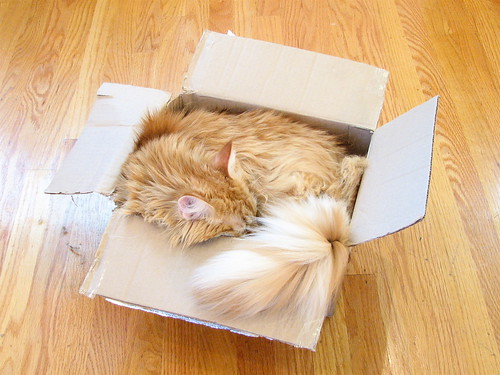How do you compute the volume of a cat?
Dunking it in water doesn’t work– you only get the volume of the rat-like creature that lives inside the cat; much like the feeble alien within a Dalek. (And, if your answer had anything to do with contour integrals, get real.)
Here is a low-tech method that works: Using successive approximation, determine the smallest box that the cat will fully enclose itself in, and measure the size of that box. Cats tend to leave a few appendages hanging out of the corners– you may need to assist with folding the cat into the box for the final stages of approximation.
This cat is approximately 648 cubic inches in volume.





Lenore — I was tempted to try & get this re-posted on Cute Overload (http://www.cuteoverload.com) but it’s stiff competition there and more strictly about Teh Qte™.
I did put it on my own Vox page, though: http://teho.vox.com/
– Theo
Thanks, Theo! Jelly’s probably happier in her box (and on your vox) than she would be on CO, anyway. She’s not exactly mainstream cute– it’s more of a geeky cute– digi-key wrapping, computers, super balls, dictionaries, etc.
Hmm. Judging by how well cats can shrink to get into someplace you don’t want, or at least expect them, and then expand to cover the entire bed or floor, I’d say that the volume of a cat is a perpetual variable.
While there is clearly no maximum, there is necessarily a *minimum* volume that is possible. This is a little bit like the concept of rest mass in relativistic physics. =)
—
Windell H. Oskay
drwho(at)evilmadscientist.com
http://www.evilmadscientist.com/
The volume is constant. The surface area is variable.
alternatively "the cat" could become a standard measurement for boxes. Like that box would be one cat and a fridge box would be 53 cats.
-Mattyfu
Much like when you buy a car at a used car lot… only hookers are the measurement. "Man this trunk is big, you could fit 3 dead hookers in here".
By immersing the cat-filled box in water, you could also calculate volume easily.
Hmm. Not much advantage to that versus using the tape measure on the box.
—
Windell H. Oskay
drwho(at)evilmadscientist.com
http://www.evilmadscientist.com/
Except that would be your own blood volume….
is it possible to cook a cat via electrocution, i wonder?
Apparently so, but we do not endorse it.
—
Windell H. Oskay
drwho(at)evilmadscientist.com
http://www.evilmadscientist.com/
XKCD, as always, has a comic that’s appropriate here:
http://xkcd.com/26/
just make sure before you put the cat in the box, there’s no radioactive particles, a geiger counter and a flask of hydrocyanic acid already in there…
I would say cats are highly variable in all measurements. Mine apparently has a minimum volume of only 0.17 ft^3, but can expand to cover an entire bed, squash himself under furniture only 2 inches off the floor, and yet can still manage to put noseprints 4 1/2 feet above the ground on pane of glass! His weight seems to fluctuate wildly too, depending if he’s sneaking onto the countertop or stomping across my face at 3am.
LOL my aunts cats act the same way
Ha ha!! I completely agree :)
Cats are a liquid. They completely fill any object into which they are placed.
I think what you meant is,
a cat is an ideal gas
I think that only applies if you have more than one cat. Two cats in a box: decrease volume> increase in pressure and/or temperature.
—
Windell H. Oskay
drwho(at)evilmadscientist.com
http://www.evilmadscientist.com/
You could place cat into a wet suit and lower into water to get the crucial volume measurement. Don’t forget to remove cat from water, wet suit (trash bag w/ straw air pipe) in roughly that order.
But that’s only if you must use water. How about using cat chow or wood chips?
Yeah, cat chow might work….
—
Windell H. Oskay
drwho(at)evilmadscientist.com
http://www.evilmadscientist.com/
Sorry, I meant Meow Mix.
You know, one time I got the volume by hiring an artist to create a life size statue of my cat. I asked him to leave it hollow inside, put a hole near the top, use clear glass for the irises, and to please let me know how much clay was used.
I then simply poured fluorescing green water into the hole noting how much was used. That combined with the clay volume equaled cat volume.
Another time, I waited for my cat to get up from her nap on a pillow into which she had sunk half-way. I then used conventional means to determine the volume of the pillow impression and multiplied that by 2.
I hope this helps.
Did you do this for real?!
Well actually, the method that you’ve outlined would be pretty hard for me to follow. My cat thinks he’s a dog, so he doesn’t really like being put in a box, and since he’s really agile, it’d be pretty hard for someone to force him in against his will!
Consider a spherical cat ….
Spherical? As long as we’re in Physics Textbook Land, I’d say it’s simpler to just regard the cat as a point mass and have done. All the equations work out easier that way. Also the point-mass assumption leads to more realistic conclusions about fencing.
no no – i’ve known spherical cats.
admittedly, also many with mass, and points – but not so much point masses.